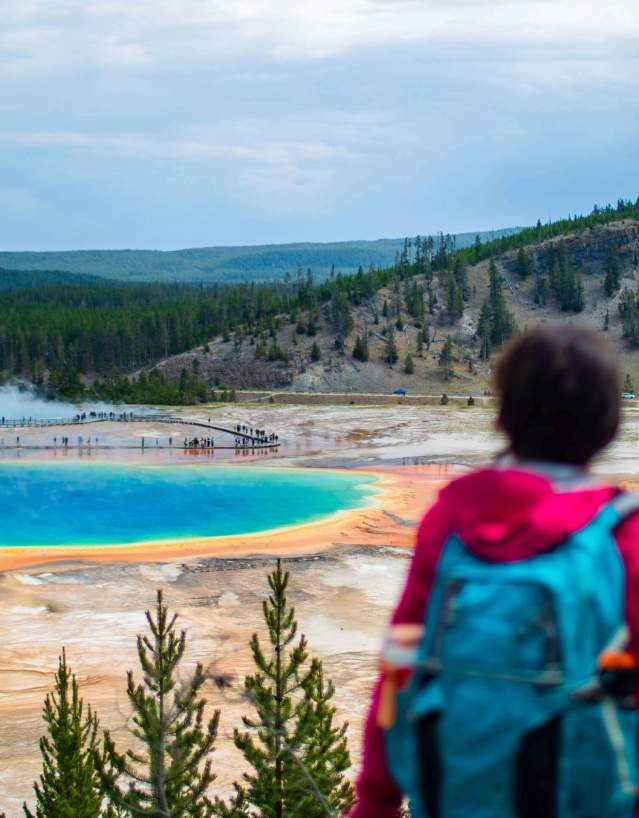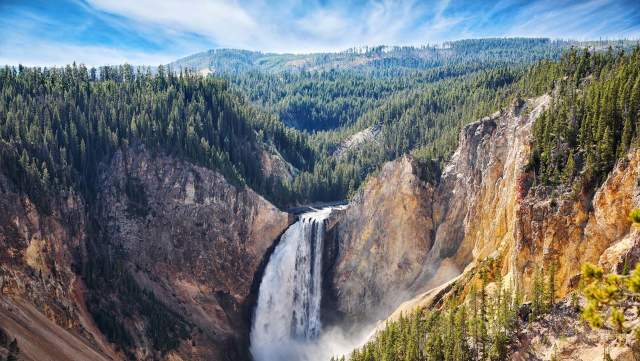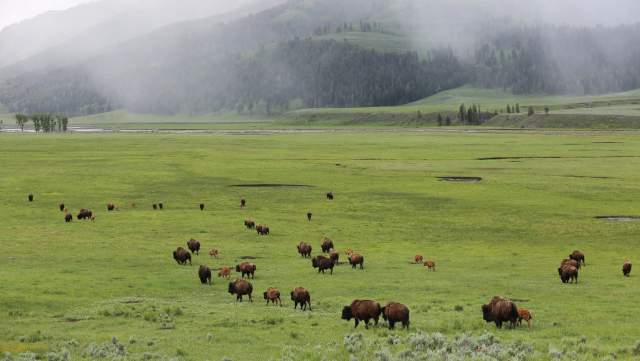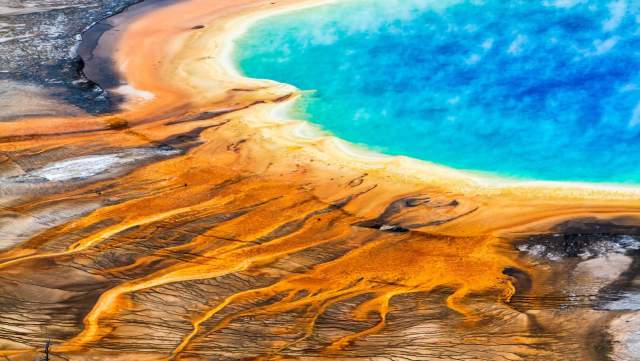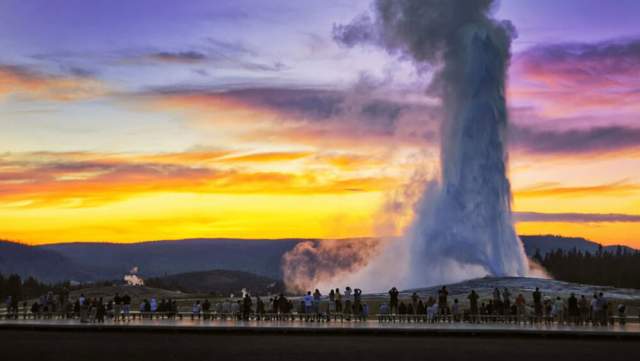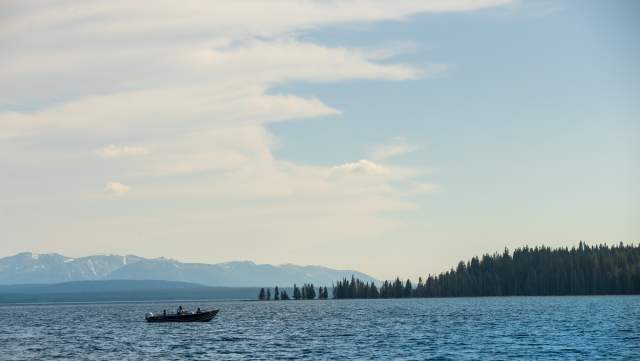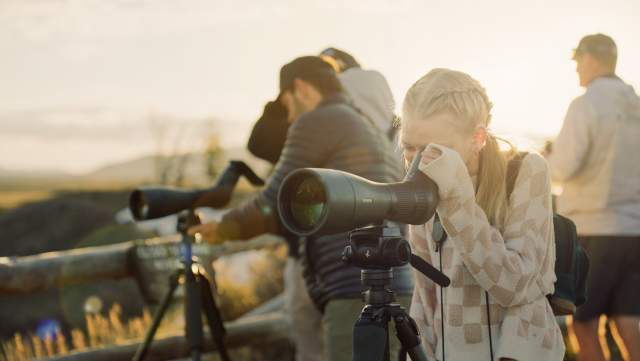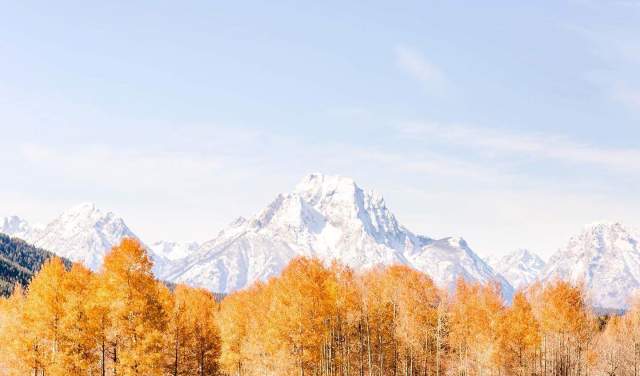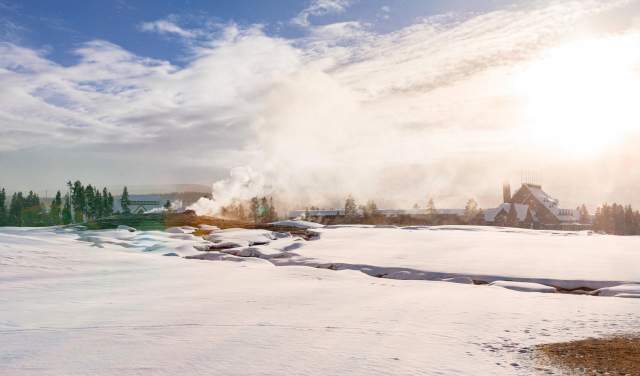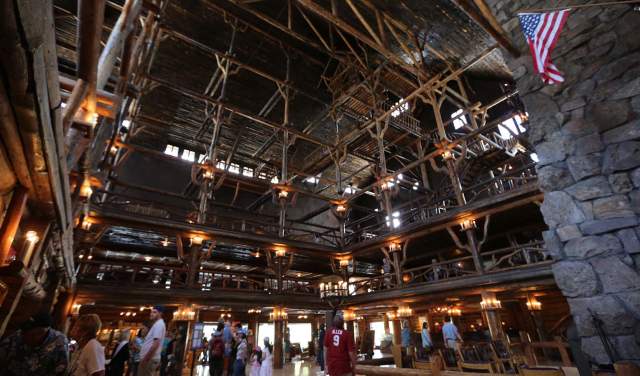Your browser is not supported for this experience.
We recommend using Chrome, Firefox, Edge, or Safari.
Yellowstone National Park
Home to an incomparable combination of natural beauty, rugged wilderness, majestic peaks, abundant wildlife, and the world’s largest concentration of geysers and thermal features, it’s no wonder Yellowstone was named America’s first national park.
From hiking and horseback riding to fishing and scenic wildlife tours, there are plenty of things to do across its 2 million acres. The iconic spots — Old Faithful, Lower Falls and Yellowstone Lake — may be familiar from paintings and photographs, but seeing them in person is a humbling, enthralling experience you can enjoy year-round. When it comes to where to stay in Yellowstone National Park, you have choices, but booking early is key. From inside the park hotels and motels to campgrounds and backcountry camping with the correct permits, there’s a perfect basecamp for your wild and wonderful Yellowstone adventure.
Map Your Yellowstone Adventure.
With more than 2.2 million acres to explore, Yellowstone offers boundless natural beauty. Within its borders are over 10,000 hydrothermal features, 466 miles of road and 92 trailheads that lead deep into the backcountry. Five entrances provide access, though some close in winter and distances between them are long, so check road status before you go. Most of Yellowstone National Park lies within Wyoming, with the gateway towns of Jackson and Cody serving as perfect starting points for exploration. Use this map to find lodging, camping, iconic landmarks, and the towns that connect you to it all.
North Entrance
Yellowstone has five entrance stations, and several are closed to regular vehicles during winter. It takes many hours to drive between these entrances, so be sure to check the status of roads at the entrance you intend to use while planning your trip and before you arrive.
Northeast Entrance
Yellowstone has five entrance stations, and several are closed to regular vehicles during winter. It takes many hours to drive between these entrances, so be sure to check the status of roads at the entrance you intend to use while planning your trip and before you arrive.
East Entrance (Cody)
Cody, Wyoming, lies 52 miles east of Yellowstone’s East Entrance. Founded by the legendary William F. “Buffalo Bill” Cody, the town brims with Western character. Visitors can enjoy nightly summer rodeos, cowboy music and the renowned Buffalo Bill Center of the West. From the East Entrance, it’s about a 40-minute, 17-mile drive to the Bridge Bay Campground on Yellowstone Lake.
West Entrance
Yellowstone has five entrance stations, and several are closed to regular vehicles during winter. It takes many hours to drive between these entrances, so be sure to check the status of roads at the entrance you intend to use while planning your trip and before you arrive.
South Entrance (near Jackson)
Jackson, Wyoming is located just 57 miles south of Yellowstone’s South Entrance, offering incredible dining, shopping, and Western spirit with the striking Teton Range as its backdrop. Entering here takes you through Grand Teton National Park, giving you the rare chance to explore two national parks in one trip. While an additional fee is required, the scenery and adventure are unmatched. Continue north about 40 miles from Jackson to reach Old Faithful and the Upper Geyser Basin.
Mammoth Campground
Open year-round, this 85-site campground is the only one in the park available all year. It is located close to fishing, hiking and the Mammoth Hot Springs Terraces. Wildlife, including elk and bison, can often be seen passing through the area.
Indian Creek Campground
This campground sits near the base of the Gallatin Mountains at an elevation of 7,300 feet. With easy access to fishing and hiking, it offers a quieter, more primitive experience. There are 70 individual campsites here, each providing space for tents or RVs along with basic amenities.
Slough Creek Campground
Tucked at the end of a two-mile dirt road, this campground is close to some of Yellowstone’s best wildlife-watching spots and known for its authentic camping experience. It’s ideal for tents and smaller RVs, with nearby trails and streams offering excellent hiking and fishing. At night, the sky opens to dazzling stars and you may even hear wolves howling in the distance.
Madison Campground
This partly wooded campground sits at an elevation of 6,800 feet and accommodates both tents and RVs. Popular with anglers, it offers easy access to fishing and is located close to Old Faithful. Visitors will find more than 270 individual campsites along with three group sites.
Lewis Lake Campground
Sitting at an elevation of 7,800 feet, this campground sits just a short walk from Lewis Lake, where visitors can enjoy canoeing, kayaking and motor boating. A boat ramp is conveniently located near the information and registration area. The campground offers 85 individual campsites.
Grant Village Campground
Grant Village includes six two-story buildings, each with 50 rooms. The complex offers a full-service restaurant, a casual lakeside eatery, a lounge and a gift shop. Conveniently located near Yellowstone Lake, it is also the closest lodging area to Grand Teton National Park.
Bridge Bay Campground
Named for its location beside Bridge Bay Marina on Yellowstone Lake, this scenic campground offers more than 400 standard campsites and 4 group sites for tents and RVs. Sitting at an elevation of 7,800 feet with stunning views of Yellowstone Lake, it’s a favorite among boaters and anglers.
Fishing Bridge RV Park
This RV park takes its name from the historic Fishing Bridge, once a popular spot for anglers. While fishing is no longer permitted, walkways still provide excellent views of waterfowl along the river. The park includes 310 campsites designated for hard-sided recreational vehicles.
Mammoth Hot Springs Hotel & Cabins
Named after nearby Mammoth Hot Springs, this historic hotel has welcomed guests since 1936 and is open in both summer and winter. It offers a range of accommodations, two restaurants and a bar, with elk often seen grazing just outside.
Roosevelt Lodge
Built in 1920 near Yellowstone’s Tower Falls area, these rustic cabins and family-style dining have long been favorites of families and anglers. A large fenced stable area, offers horseback trail rides, stagecoach adventures and the popular Old West Dinner Cookout, an evening where guests travel by horseback or wagon to a scenic spot for a hearty Western-style meal served under the open sky.
Canyon Lodge
As Yellowstone’s largest lodge, this expansive retreat offers more than 500 rooms and cabins, giving guests a comfortable base in the heart of the park. Beyond its accommodations, the lodge welcomes guests to enjoy casual meals at the café or grill and to indulge in sweet treats at the ice cream shop.
Old Faithful Snow Lodge
The Old Faithful Snow Lodge is the newest hotel in the park, open to guests in both summer and winter. With its log columns and cedar-shingle roof, it stands as a striking example of classic “parkitecture.” Visitors can choose between full-service dining or a casual meal at the Geyser Grill.
Grant Village
Grant Village features 6 two-story buildings each containing 50 rooms; none have elevators. The lodging complex features a full-service restaurant, a lakeside restaurant with a casual menu, lounge and gift store. The village is also nearest to Grand Teton National Park.
Mammoth Hot Springs
If you’re looking to see a lot of hot springs in one place, Mammoth Hot Springs in Yellowstone National Park is the place for you. This must-see feature at Yellowstone includes upper and lower terrace boardwalks with around 50 individual hot springs.
Lamar Valley
Located in the northeast corner of the park, Lamar Valley is renowned for its rich wildlife, including elk, bison, wolves, moose and bears. The Lamar River also draws anglers with its healthy trout population. From Hayden Valley, it’s about 73.5 miles, or just over two hours, to reach Lamar Valley.
Grand Canyon of Yellowstone
Carved by the Yellowstone River, this dramatic canyon is best known for its iconic Lower Falls, where the river plunges more than twice the height of Niagara Falls into the canyon below. From Bridge Bay on Yellowstone Lake, it’s about 20 miles, or a 45-minute drive, to the Grand Canyon of the Yellowstone.
Grand Prismatic Spring
Grand Prismatic Spring is the largest hot spring in Yellowstone and the third largest in the world. Its brilliant colors come from heat-loving bacteria that thrive in the steaming, mineral-rich water. Visitors can admire the spring from boardwalks at ground level or hike to the overlook for a sweeping view of this iconic geothermal wonder.
Old Faithful
Old Faithful is Yellowstone’s most famous geyser, erupting with remarkable consistency for centuries. Its predictable bursts helped inspire the creation of Yellowstone as the world’s first national park in 1872. Today, it remains one of nearly 500 geysers in the park and one of the few rangers can reliably predict.
Yellowstone Lake
Sitting at 7,733 feet, Yellowstone Lake is the largest high-altitude mountain lake in North America. Spanning 20 miles by 14 miles with over 100 miles of shoreline, it reaches depths of 320 feet. Anglers come for native cutthroat trout, while boaters and visitors enjoy its vast scenic beauty.
Wildlife Safety
For the safety of wildlife and visitors, please keep your distance from all animals. It’s recommended to stay at least 100 yards away from bears and wolves and at least 25 yards away from all other wildlife. Learn more about how to explore the park safely by following WY Responsibly guidelines.
*Not for navigational purposes
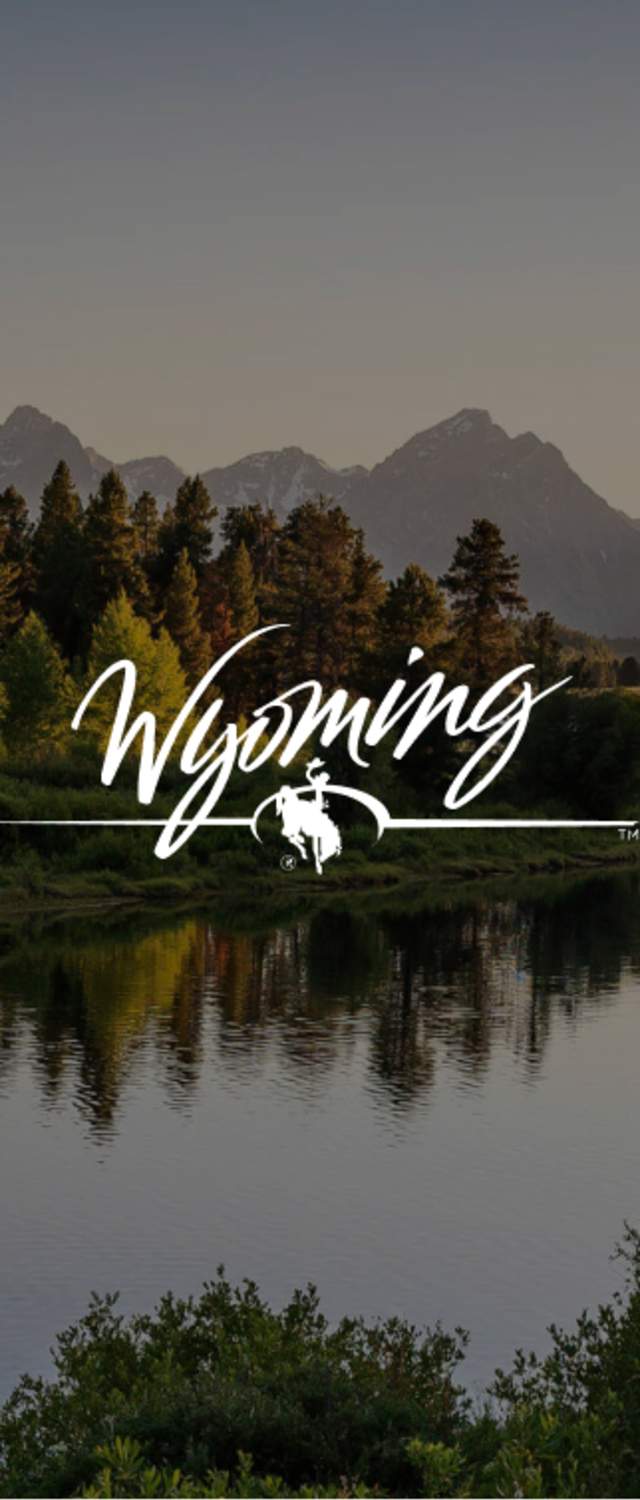
Related Articles & Itineraries
Top 12 Things to Do in Yellowstone National Park
- 11 min read
Your Winter Guide to Yellowstone National Park
- 8 min read
Where to Stay in and Near Yellowstone National Park
- 5 min read
What is Yellowstone National Park?
Yellowstone National Park is a 2.2 million acre section of land in Wyoming, Idaho and Montana that the government set aside to preserve the area’s diverse environment. Yellowstone is the world’s first national park and the second most popular national park in the United States. The area within this national park is known as the Greater Yellowstone Ecosystem. Within Yellowstone National Park’s borders, you can find geysers, hot springs, waterfalls, wildlife and much more.
How big is Yellowstone National Park?
Yellowstone National Park covers over 2.2 million acres.
Why is Yellowstone National Park famous?
Yellowstone National Park is famous for being the first national park in the world and for featuring the most geysers and hot springs in the world, including Old Faithful and Grand Prismatic Spring.
What year did Yellowstone become a national park?
Yellowstone became the world’s first national park in 1872.
Where is Yellowstone National Park, and is it only in Wyoming?
Yellowstone National Park sits in the northwest corner of Wyoming. Most of Yellowstone National Park—96 percent—is in Wyoming, while the remaining portions are shared between Montana and Idaho.
Where is the best place to stay in Yellowstone National Park?
Yellowstone National Park has nine lodges. All are open from late spring through fall. Two remain open in the winter. If you’re looking to camp, you’ll find 12 campgrounds throughout the park. All sites must be reserved.
How far in advance do you need to plan a trip to Yellowstone?
We recommend planning your trip to Yellowstone nine months to a year in advance. Most lodging within the park requires reservations and books quickly.
How far is Glacier National Park from Yellowstone?
The driving distance between Glacier National Park and Yellowstone is 441 miles or about 8 hours. Glacier is located in northwest Montana, while Yellowstone National Park is in northwest Wyoming.
What is the closest airport to Yellowstone National Park?
The closest airport to Yellowstone National Park in Wyoming is Yellowstone Regional Airport, located in Cody. Any of Wyoming’s nine airports offer connecting flights from larger international airports like Salt Lake City and Denver. Find more Wyoming airports here.
How many days do you need in Yellowstone National Park?
To see most of the popular destinations in Yellowstone National Park, you should plan for at least 2 to 3 days. If you’re looking for a more in-depth visit to this sprawling national park, plan for about a week. This itinerary highlights a few different ways to explore Yellowstone.
What is the best month to visit Yellowstone National Park?
For the best summer weather, you should visit Yellowstone National Park between June and August. For smaller crowds, plan your trip for late April or early September. Since Yellowstone is the second most popular national park, visiting during these less popular times can make for a more enjoyable experience.
Is Yellowstone National Park accessible for travelers with disabilities?
Yellowstone National Park is accessible for travelers with disabilities, with features like boardwalks, paved paths, specific backcountry sites, ranger programs and more. Check out this article to learn more about accessibility in Wyoming’s national parks.
Are dogs allowed in Yellowstone National Park?
Pets are allowed in Yellowstone National Park. However, they must be kept on a leash at all times (unless they’re in a car or crate). Pets may only accompany people in developed areas and are not allowed on hiking trails, with the exception of qualified service animals. Visit the National Park Service website for more information.
